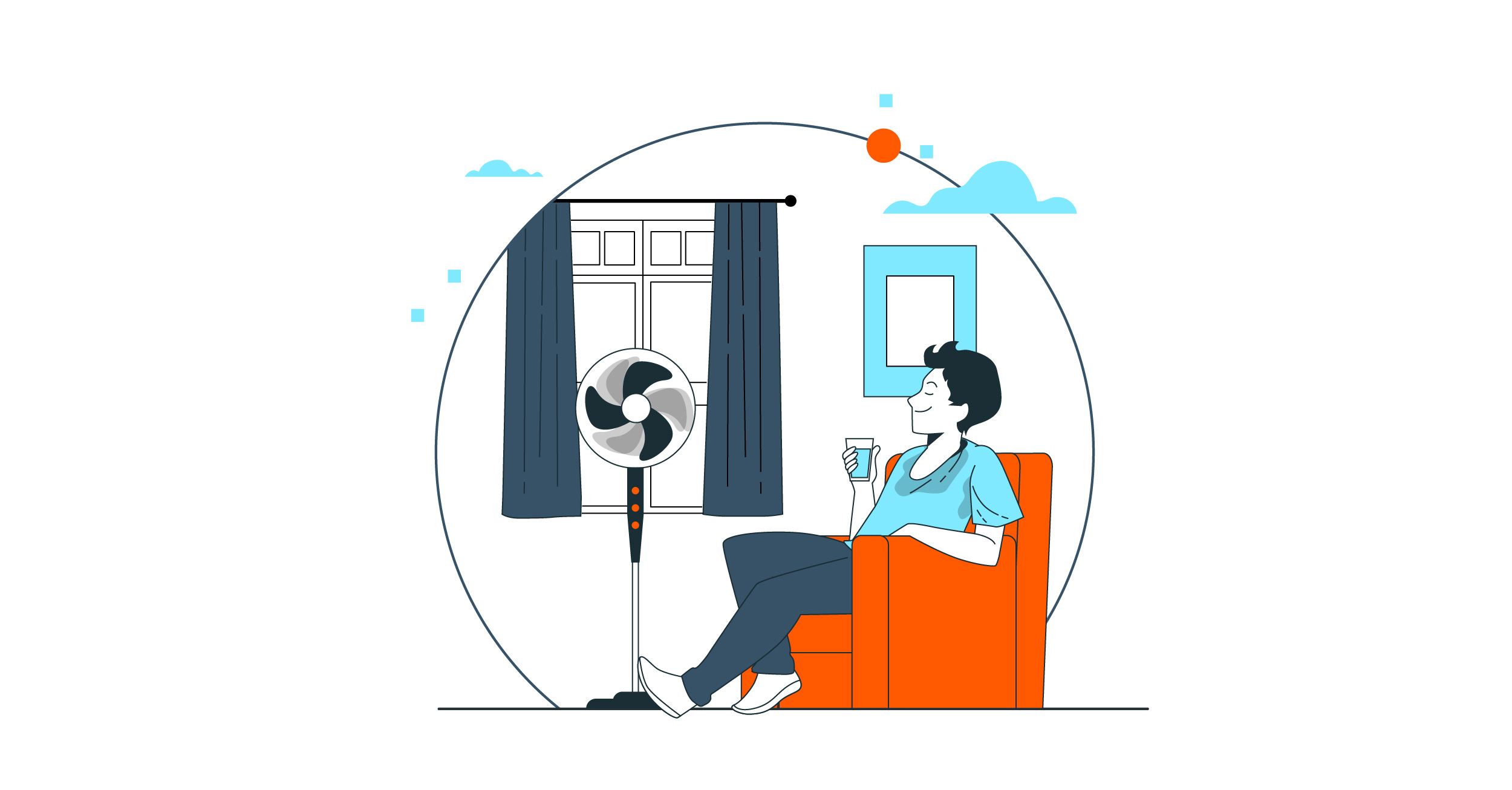
Fair wear and tear is one of the most common sources of disagreement between landlords and tenants at the end of a tenancy.
It refers to the normal, gradual deterioration of a rental property over time. Landlords cannot deduct the cost of these kinds of repairs from a resident’s deposit.
This is opposed to damage caused by neglect, accidents, or misuse, for which a landlord can make deductions.
However, fair wear and tear is a vague term, and deposit disputes surrounding this issue are common in the UK, with tenancy deposit schemes handling tens of thousands of cases each year.
Understanding what fair wear and tear means is crucial for both landlords and residents, as it affects how tenancy deposits are returned and how disputes are resolved.
In this guide, we’ll explain what counts as fair wear and tear and how to tell it apart from damage.
Fair Wear and Tear Definition
UK law defines fair wear and tear as "reasonable use of the premises by the tenant and the ordinary operation of natural forces." In plain English, it’s the normal, gradual deterioration of a rental property that happens through everyday use.
This accepted principle applies to the condition of the rented property and its fixtures. For example, paintwork fading over time is reasonable wear and tear; paintwork getting chipped by poorly stored bikes is not.
The table below compares three examples of repair issues, the causes, and who’s typically responsible.
|
Example |
Likely cause |
Type |
Responsibility |
|
Carpet becoming faded in a hallway |
Regular foot traffic over several years |
Fair wear and tear |
Landlord |
|
Water damage to a carpet due to a burst pipe |
Fault in the property’s plumbing |
Repair issue from wear and tear |
Landlord |
|
Carpet chewed by a puppy while the owners were out |
Accidental or careless tenant action |
Tenant damage |
Tenant |
However, few landlords or tenants have read the guidance, meaning they are unclear on the definition, which can lead to unnecessary disputes.
In short:
-
Reasonable wear and tear is unavoidable and part of a landlord’s maintenance duty.
-
Tenant damage is preventable and should be remedied or paid for by the tenant.
🧹 Is cleaning (or a lack of) considered wear and tear?No. Cleaning is covered under a different set of rules. However, most tenancy agreements include a clause requiring residents to return their property to the same condition it was in when they moved in, minus wear and tear. If this isn’t met, then landlords have the right to deduct funds from the resident’s deposit or charge them for hiring a professional cleaner, depending on the extent of the cleaning required. In other words, if the property was spotless when a tenant moved in, it should be spotless again when they move out. However, they wouldn’t need to repaint the walls, for example, as this would be the landlord’s responsibility under fair wear and tear. For more information, check out our guide on end-of-tenancy cleaning laws. |
Factors That Affect What’s “Fair”
Several factors influence whether deterioration is considered fair wear and tear. These include:
-
Length of tenancy: Longer tenancies naturally lead to more wear.
-
Number of occupants: Families with multiple residents will generally create more wear than single occupants.
-
Quality and age of damaged items at start of the tenancy: Older or lower-quality fixtures wear out faster.
-
Expected life span: Industry benchmarks help set expectations (see table below).
-
High-traffic areas: Areas like hallways or living rooms wear faster than rarely used rooms.
-
Average tenancy length: In England, the average private rented sector tenancy lasts around 4.1 years. Landlords should expect more wear and tear at the end of longer tenancies.
-
Households with children or pets: Children and pets tend to create a higher level of wear and tear than adults, so greater wear and tear can be expected where they are present. Approximately 34% of PRS households have dependent children.
Item lifespans
Industry guidance recognises that every item has a lifespan. For example, a mid-range carpet typically lasts 5–7 years, and interior paintwork about 5 years, depending on quality and usage.
These benchmarks help determine whether an item has experienced reasonable deterioration or if it should be classified as damaged. Here are a few expected lifespan benchmarks:
|
Item |
Typical lifespan |
|
Mid-range carpet |
5–7 years |
|
Interior paintwork |
~5 years |
|
Fridge-freezer |
8–10 years |
|
Washing machine |
5–7 years |
✔️ Examples: What constitutes fair wear and tear
Here are typical instances you’ll see across a property, separated into clear categories for easy reading:
Fixtures and fittings
-
Loose cupboard hinges or handles from regular use.
-
Slight fading or dulling of paint over several years.
Flooring
-
Worn carpets in high-traffic areas like hallways.
-
Minor scratches on hardwood floors from normal foot traffic.
Walls and paintwork
-
Minor scuff marks caused by moving furniture.
-
Nail holes from hanging pictures (if reasonably placed and permitted).
Soft furnishings
-
Slight discoloration or wear on curtains or blinds due to sunlight exposure.
-
General flattening of mattresses from regular use.
❌ What’s not fair wear and tear?
These are examples where deterioration goes beyond normal use and the tenant is typically responsible:
-
Flooring damage: Large red wine stains, cigarette burns, or pet urine damage to carpets.
-
Walls: Deep holes, large gouges, or unapproved redecoration (e.g. bright or garish paint changes).
-
Fixtures/fittings: Cracked windows, broken doors, or missing items like light fittings.
-
Soft furnishings: Torn or heavily stained curtains or damaged upholstered furniture.
-
Pet damage: Pets may cause some minor wear (a few light scratches or hair), but pet-related damage (urine stains, chew marks, deep scratches) is treated like tenant damage, not normal wear and tear.
Betterment and apportionmentWhen deciding on deductions for damage, landlords must avoid “betterment.” This means they cannot use a tenant’s deposit to replace or upgrade an item to a better condition than it was at the start of the tenancy. For example, if a mid-range carpet was already three years into its expected five-year lifespan, and the tenant caused severe damage (such as a large burn or permanent stain), the landlord could not charge the tenant the full cost of a brand-new carpet. Doing so would leave the landlord in a better position than before. Instead, adjudicators apply apportionment, a calculation that considers the item’s age, quality, and expected lifespan. This ensures the tenant only pays for the portion of the item’s remaining life lost due to their actions. Let’s use our carpet example again to explain the betterment formula:
If the deterioration is due to fair wear and tear alone, no deduction can be made. Deposit schemes such as TDS and SafeDeposits Scotland provide guidance on applying these principles. |
How Wear and Tear Is Assessed
Adjudicators and landlords rely on a mix of evidence and professional judgment to decide whether deterioration is due to fair wear and tear or tenant damage.
The key is having clear written records of the rental property’s condition at the start and end of the tenancy.
Assessing fair wear and tear involves:
-
Use check-in and check-out reports
Make an inventory checklist before the resident moves in and then check the rental property against it when they move out. A check-in report provides a before-and-after comparison that helps identify what’s changed and whether it’s reasonable.
Ensure your inventory is dated and includes photographs. Adjudicators give more weight to high-quality visual evidence than to written descriptions alone.
-
Carry out mid-tenancy inspections
Periodic inspections allow landlords to track deterioration and deal with maintenance issues early. This can prevent potential conflict and ensure wear is proportional to the length of the tenancy and usage.
-
Follow professional standards and guidance
As discussed, deposit schemes such as the Tenancy Deposit Scheme (TDS) and SafeDeposits Scotland publish guidelines for assessing wear and tear, including expected lifespans and factors like occupancy levels and item quality.
-
Keep supporting documents
Receipts, invoices, and maintenance logs can help establish an item’s age, quality, and previous condition, which are all critical in determining whether proposed costs for replacement are justifiedWithout strong evidence provided, it’s harder for adjudicators to see whether that deterioration goes beyond fair wear and tear, meaning landlords are less likely to win a deposit deduction claim.
How to Reduce Wear and Tear
While wear and tear is inevitable, both landlords and tenants can take steps to slow it down and keep properties in good condition.
Proactive care benefits both parties; landlords spend less on repairs, and tenants are more likely to receive their full deposit back at the end of the tenancy.
Here are some of the steps landlords and residents can take:
Landlords can:
Schedule regular inspections: Carry out inspections every 6–12 months to spot issues early, arrange repairs, and ensure planned preventative maintenance stays on track.
Choose durable finishes: Opt for hard-wearing materials such as washable paint, stain-resistant carpets, and robust fittings that can withstand daily use.
Foster a good relationship with residents: Clear communication encourages tenants to report problems quickly, preventing minor issues from becoming costly repairs.
Tenants can:
Report issues early: Notify the landlord or agent about leaks, damage, or appliance problems as soon as they occur to avoid further deterioration.
Use protective measures: Make sure there are mats at entrances, use furniture pads, and keep pets away from vulnerable areas to prevent unnecessary damage.
Clean regularly: Routine cleaning prevents dirt build-up and extends the life of fixtures and fittings, especially in kitchens and bathrooms where limescale can build up and cause damage.
EVO: Helping You Deal With Wear and Tear
Dealing with wear and tear is part of being a landlord. Whether it’s fixing a rental property up between tenancies ready for the next resident, or replacing something due to a request, you likely get a lot of these requests, especially if you manage hundreds or even thousands of properties.
That’s where EVO comes in. We provide a digital platform that housing providers can outsource all of their repairs and maintenance operation to.
Our powerful combination of modern technology, data and automation makes life easier for housing providers while also improving the quality and efficiency of their repairs and maintenance.
Here’s how it works:
Report: Tenants log repairs or issues instantly via the EVO app, including photos or videos.
Match: One of the approved contractors will accept the job.
Schedule: App-based scheduling allows tenants to choose convenient appointment times, leading to lower numbers of no access visits.
Track: Both landlords and tenants can track job progress in real time.
Complete: Once the work is finished the contractors upload photos. EVO then signs it off in the system, do quality checks and sends the resident a CSAT to measure satisfaction. All work is given a 12-month warranty by EVO meaning landlords only need to deal with one provider, and not lots of individual trades people.
It’s ideal for managing wear and tear in your properties. Housing providers can schedule inspections and log photos and notes in the property history.
Get in touch to find out how EVO could help you provide better quality housing.
PHOTO BY EVO


